-
 Liu
Hi there! Welcome to my shop. Let me know if you have any questions.
Liu
Hi there! Welcome to my shop. Let me know if you have any questions.
Your message has exceeded the limit.

Artificial Bamboo Privacy Fence: The Trend in Bamboo Screening Solutions
2025-10-27 15:57:21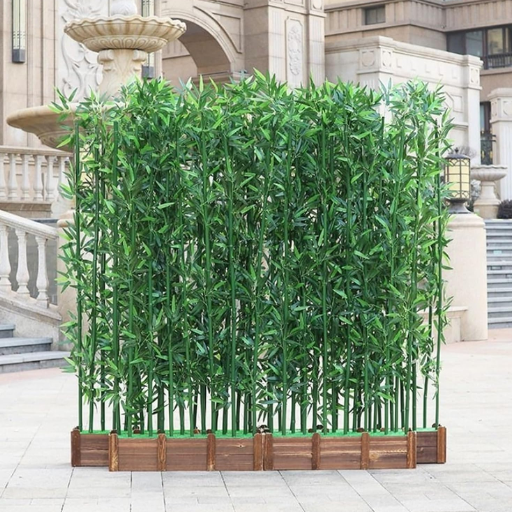
The growing consumer interest in privacy solutions that are both sustainable and stylish has sent artificial bamboo privacy fences to the top of this trend. These new screening options not only offer a perfect blend of style and utility but also feature the timeless look of natural bamboo and the ease of use and durability of contemporary materials. Artificial bamboo fences, in particular, are an apt choice if you want to add privacy to your outdoor area, reduce noise, or just give your garden a new look, as they are versatile and low-maintenance alternatives to traditional fencing methods. In this post, we will discuss the reasons for the growing popularity of artificial bamboo privacy fences, their main advantages, and how they can turn your space into a peaceful, secluded oasis. Find more info now .
Introduction to Bamboo Privacy Solutions
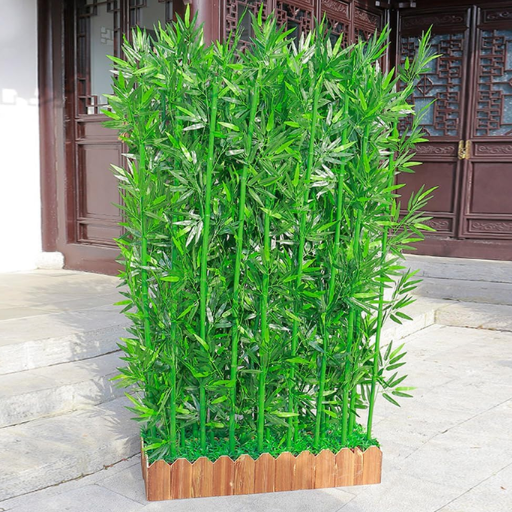
Bamboo privacy solutions are types of fences that serve to isolate and relax the outdoor areas. The materials for these solutions may be either natural bamboo or artificial bamboo, which both contribute to the privacy of the space and at the same time have a positive effect on its appearance. Fencing made of artificial bamboo is especially favored due to its long life, minimal maintenance requirements, and resistance to the elements. They are a green choice that blends practical use with artistic interpretation and offers a fashionable way to make spaces feel private and limit visibility.
Growing Popularity of Bamboo Fences
Bamboo fences are gaining increasing acceptance, and their sales have risen significantly since people have become aware of the benefits they offer to the environment and to people who prefer such landscaping. However, a major indicator of the change is a more than 40% increase in search frequency for "Bamboo fencing ideas" over the last two years, which is surprising not only for homeowners but also for businesses; as such, Forbes even noted this trend.
Bamboo's advantages and its eco-friendliness drive this movement. To start with, bamboo is a renewable material used in construction and furniture-making. Moreover, it is a good resource for people who want to reduce their ecological footprint. To enhance the above and also to stimulate the markets, the recent developments have lengthened the life and also bettered the customizable options for bamboo fences which in turn has made them even more usable in different weather and taste. Apart from the above-mentioned advantages of bamboo, its working of modern innovations has now even expanded and adapted bamboo so well that it provides customers with so many styles ranging from black bamboo which gives a contemporary look to a rustic charm through white woven panels, thus creating a variety of outdoor spaces through personalization with the concept of fences that provide endless possibilities.
The global market for the entire line of bamboo products including fencing is estimated to grow as high as $98 billion by 2030 according to the release of data from industry reports and this is one of the main reason why bamboo is increasingly being viewed and used as a sustainable material for not only renovation but also application in a calming way through surrounding with the outdoor space and inside through the walls and flooring. Aesthetics, functionality, and eco-friendliness are the key features of bamboo fences, making them the darling of modern landscape architects worldwide.
Benefits of Using Artificial Bamboo for Privacy
Durability and Low Maintenance
Artificial bamboo is extremely sturdy but has a much shorter lifespan than natural bamboo. It can withstand all weather conditions, pests, and rot, making it suitable for practical privacy solutions over the long term.
Realistic Aesthetic Appeal
Modern artificial bamboo has been developed to imitate the natural bamboo both in appearance and features closely, therefore giving an atmosphere that is beautiful and friendly to the environment but at the same time not requiring the problems and maintenance of natural materials.
Ease of Installation
Installation of artificial bamboo fences is light and simple. They can be erected quickly and without special tools or labor, ultimately saving time and effort on landscape projects.
Cost-Effectiveness
The upfront cost may be different in some cases, but in the long run, artificial bamboo is a less expensive choice as it needs no treatment, no replacement in process, or extensive maintenance, and overall it is a cost-efficient option for privacy.
Customizable Options
Homeowners and designers can choose from a wide range of artificial bamboo fences in various sizes, colors, and styles to suit their tastes and functional needs, giving them the flexibility to fit their outdoor spaces with different styles.
Overview of Artificial vs. Natural Bamboo
Parameter | Natural Bamboo | Artificial Bamboo |
|---|---|---|
Material | Natural bamboo | Synthetic resin |
Durability | Prone to decay and weathering | Highly durable and weather-resistant |
Maintenance | Requires regular upkeep | Minimal maintenance needed |
Appearance | Warm, traditional, and natural texture | Realistic bamboo look, customizable |
Cost | Generally lower upfront cost | Higher initial cost |
Environmental Impact | Biodegradable but less sustainable | Made from recyclable materials |
Installation | Requires skilled craftsmanship | Easy, modular installation |
Weather Resistance | Susceptible to rain, sun, and cold | Resistant to all weather conditions |
Longevity | Short lifespan without maintenance | Long-lasting |
Applications | Traditional gardens, rustic settings | Modern, versatile outdoor spaces |
Advantages of Artificial Bamboo Privacy Fences
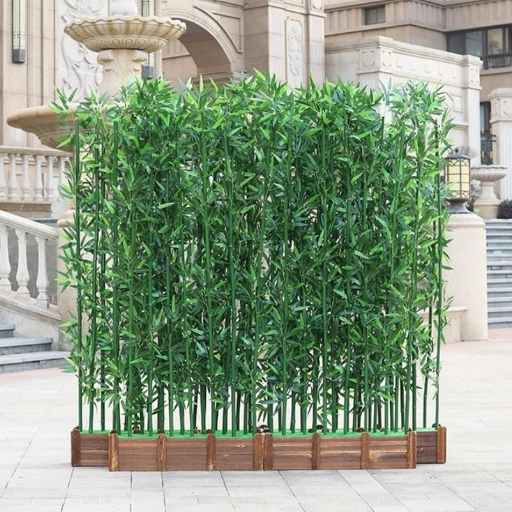
Durability and Longevity
The use of artificial bamboo fences offers the advantage of weather resistance, accommodating rain, wind, and UV exposure; thus, such fences will not only remain but also remain attractive and sturdy for years. They will not rot, crack, or fade; hence, the manufacturers consider them a durable feature for the homeowners.
Low Maintenance
Compared to natural bamboo fences, artificial bamboo fences require almost no maintenance. The regular cleaning with water is often enough to keep them looking immaculate, while the use of areas are given to treatments, staining and regular repairs.
Cost-Effectiveness
The initial investment for artificial bamboo may be slightly higher than for natural bamboo, but the long-term savings from reduced maintenance, replacement costs, and greater durability make it a prudent choice. Homeowners will have a considerable amount saved through avoiding frequent replacement and repairs.
Pest and Mold Resistance
Bamboo that is not natural is free of common problems like insects or mold, which, on the other hand, are main concerns with natural bamboo. This gives a no-worry period regarding cleanliness and a pest-free outdoor space.
Eco-Friendly Options
The majority of artificial bamboo fences are made from recyclable or sustainable materials, making them an eco-friendly alternative. In this way, they not only help conserve the planet's resources but also provide the same nice look as natural bamboo.
Durability and Longevity of Synthetic Bamboo
Synthetic bamboo has been engineered to last a long time and offers outstanding durability and resilience compared to the original. The synthetic bamboo production has been made possible by technology and it is made of high-density polyethylene or other polymers that are incredibly strong and resistant to weather, insects, and fungi. Natural bamboo, on the other hand, is not very durable in moisture and eventually rots and decays; synthetic bamboo, however, is waterproof and will last for decades, needing practically no maintenance.
Studies show that top-notch synthetic bamboo can last 20 to 30 years at most, given environmental factors and product quality. UV-resistant coatings play a significant role in prolonging its life by preventing fading and brittleness caused by sun exposure over time. For example, some brands claim that their products can tolerate extreme temperatures between -40°F (-40°C) and over 140°F (60°C) thus providing reliable performance in both hot and cold weather. Moreover, synthetic bamboo is fortified with anti-corrosive and anti-fungal properties, making it an ideal candidate for outdoor installations.
The above-mentioned durable characteristics are not only the reason for reduced replacement costs but also for decreased environmental impact due to reduced waste. The structures made of synthetic bamboo, such as fences and furniture, can last for years, remain visually appealing, and be structurally sound, making them a smart long-term investment not only for residential but also for commercial properties.
Eco-Friendly Options in Bamboo Screening
Bamboo screening has proven to be a sustainable, eco-friendly option for both residential and commercial landscaping projects. In contrast to conventional timber, bamboo grows much faster, with some species maturing in 3-5 years, while most hardwoods take 20-50 years. Bamboo's rapid growth makes it a highly renewable resource, reducing the need to cut down trees and helping maintain the balance of nature. Besides, the bamboo plant has a higher capacity for carbon dioxide absorption and oxygen production than many other plants, further enhancing its environmental benefits.
The advanced application of manufacturing techniques has increased the variety of eco-friendly bamboo screening options. For example, ready-made bamboo panels are produced from sustainably sourced biomass and finished with non-toxic coatings to enhance their lifespan while keeping harmful chemicals out of the manufacturing process. The industry reports indicate that such panels can last 15-20 years if properly maintained, making them a cost-effective and environmentally sound choice.
Another modern innovation is composite bamboo screening, which is formed by mixing bamboo fibers with recycled plastic to produce a low-maintenance, very durable material. This type is water- and bug-resistant, as well as non-fading, making it well-suited for outdoor use in severe weather conditions. Studies indicate that bamboo composite products may contain up to 50-60% recycled material, resulting in a substantial reduction in their ecological footprint.
No matter whether going for conventional bamboo fences or modern composites, all those eco-friendly alternatives will be a big help for waste management and for implementing environmentally friendly practices in the landscaping design.
Unique Look and Aesthetic Appeal
For a long time now, bamboo has been a material that is liked for its natural and elegant look which can easily fit into different landscaping and interior design styles. Bamboo has a very distinct texture and warm shades that can create a relaxing, Zen-like vibe, making it a good option for modern, rustic, or minimalist designs. Recent trend analyses indicate that bamboo products are experiencing great popularity, the global bamboo market is estimated to reach $82 billion by 2028 with a compounded annual growth rate (CAGR) of 5.7%.
Bamboo is very much versatile in terms of design, so it can be woven into complex patterns, used as sleek slats, or whole canes can be added as it is. Its adaptability allows bamboo to be fashioned to represent anything from the old style of tropical aesthetics to modern-day architectural accents. In addition, advanced processing technologies have expanded the field of bamboo finishes, offering options from matte to glossy, ensuring that bamboo fits with even the most diverse design preferences. Given its innate beauty and customization potential, bamboo has not only been a sustainable but also a fashionable component in the making of modern designs.
Installation Tips and Tricks for Bamboo Fences
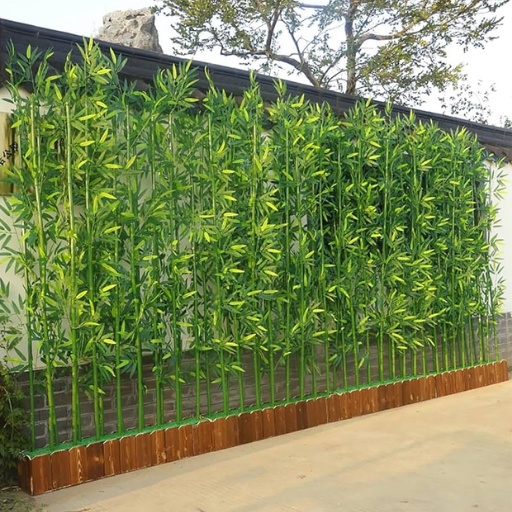
Choose the Right Bamboo Type
Ensure quality bamboo is treated and weatherproofed for long-lasting usage. Prefer varieties such as Moso or Guadua bamboo which are recognized for their hardness and power to fight off outdoor elements.
Prepare the Ground Properly
Ground level and preparation should meet the set standard before the installation starts. Making holes at least 18-24 inches deep is recommended for fence posts thus providing enough support and stability. Either gravel or concrete can be used to anchor the posts securely.
Use Stainless Steel Fasteners or Ties
Your bamboo fence will last longer if you apply stainless steel screws or rust-resistant zip ties. Using these materials will protect the fence from corrosion and maintain its integrity over time.
Apply Protective Sealant
Bamboo should be coated with UV protective sealant to shield it against the effects of sun and rain. The sealant should be reapplied every 1-2 years to keep the fencing in good condition and looking good.
Allow for Airflow
situation: spacing bamboo panels with sufficient distance or making openings below the panels. This will facilitate air movement, prevent moisture from collecting, and make it easier to prevent mold or rot in warm areas.
Choosing the Right Bamboo Panel Size
The size of the bamboo panels you choose for your project is an essential factor to consider alongside the intended use, available space, and structural needs. Bamboo panels are generally offered in the standard heights of 3, 4, 6, and 8 feet, with widths from 3 to 8 feet. Decorative panels are usually thinner and suited to smaller outdoor spaces, while thicker panels are used for fence installations or structures that provide greater durability and privacy.
Consider using 1 inch or bigger diameter panels for a strong and lasting fence. Thinner panels with a diameter of about 0.5 inches are perfect for decorative and indoor use. Market research and online sellers indicate that the most sought-after panel dimension for residential fences is 6 feet tall and 8 feet wide providing the best privacy without cramping the space. Additionally, custom sizes are sometimes available upon request for projects with special dimensions or designs.
It is important to consider the distance between the panels, as ventilation is vital to the lifespan of the bamboo. Moreover, it has been found in the studies that pre-treated bamboo with UV coating can keep the panels last longer by up to five years since the damage caused by the weather is reduced significantly. Analyze your project's requirements meticulously and measure the sizes against the available space to make the right decision.
Step-by-Step Guide to Easy Installation
Step 1: Prepare the Workspace
Installation of bamboo panels begins by cleaning the area of all debris. Measure and mark the installation site to confirm the size meets your project requirements. Recent findings show that a flat surface can reduce structural stress by up to 15%.
Step 2: Gather Necessary Tools
An installation job without proper tools means inefficiency. The most common tools are a measuring tape, a drill, screws, a screwdriver, and safety gear like gloves and goggles. It is advised that one uses stainless steel screws as they prevent rust which is a slow process but can be a problem in wet or outdoor conditions.
Step 3: Install the Support Structure
Depending on the type of your project, mount a framework or a base to support the bamboo panels. Have the support beams spaced properly—12 to 16 inches apart is best—so the panels can share the weight evenly and not bend. Studies show that optimal spacing provides 20% greater durability for the structures.
Step 4: Secure the Panels
The panels should be positioned according to your markings. Use the pre-drilled holes to fix each panel to the support structure which will help in reducing splitting. Secure the panels, but do not crank the screws too much, as this can damage the material. It would be good to use a spacer tool to set the airflow gaps, which can add an average of 5 years to the panels' lifespan.
Step 5: Apply Protective Coating
For projects done outside or in areas that receive direct sunlight, applying a UV-resistant coating would be ideal to protect the bamboo from fading and cracking. Research indicates that panels that are coated last up to 40% longer even under harsh weather.
Step 6: Inspect and Finalize
Go over the whole installation process to assure that all the panels are locked firmly and well spaced. A small stability test by applying light pressure to the structure can tell you whether the adjustments are still needed. If the major adjustments are needed then the project will not be marked as complete.
It is through these straightforward steps and the proper use of materials and tools that you will achieve an efficient, durable bamboo panel installation that unifies practicality and beauty.
Common Mistakes to Avoid When Installing
Improper Installation Surface Preparation
The failure to clean and level the installation surface can cause panels to be uneven and the structure to be unstable. Always check that the surface is clear of debris and level before proceeding with the installation.
Use of Wrong Tools or Materials
Using incorrect tools or poor-quality materials can negatively impact installation quality and durability. Consider, for example, using nails instead of screws, which may result in loose panels over time.
Measurement Skipping
If measurements are not accurately done before panels are cut or drilling, it could lead to gaps, misalignment of panels, or material wastage. Always take the extra precaution of measuring twice to avoid errors that could cost you.
Failure to Seal Bamboo Panels
Bamboo is a treatment-dependent material in that its moisture and pest susceptibility comes without the sealant. One might think treating bamboo with a sealant is unnecessary; this is particularly true for outdoor installations, as untreated panels will eventually succumb to the elements and become damaged.
Fasteners Tensioning Beyond Limits
Bamboo panels can crack or split due to screws or bolts that are overly tightened. Use moderate pressure and stop when the panel is fastened securely without causing damage.
Comparing Artificial vs. Natural Bamboo
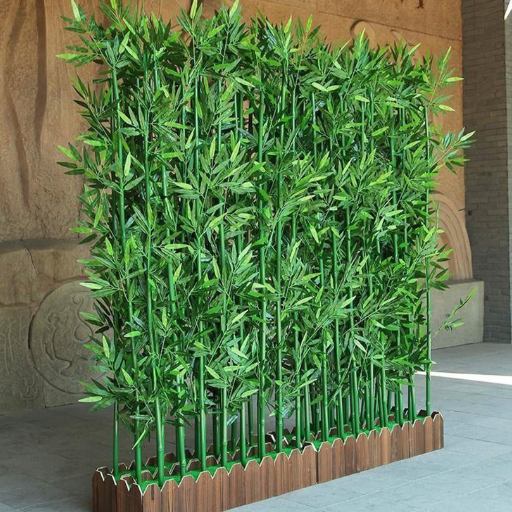
Choosing between artificial and natural bamboo requires comparing their features to pick the right one for the project. The following are five main points that can be taken into account:
Durability
Artificial Bamboo: It is made from synthetic materials, giving it high resistance to weather, humidity, and pests. Thus, it is more durable than natural bamboo and requires fewer treatments when used outdoors.
Natural Bamboo: It possesses natural strength, but the maintenance, sealing, and other measures required to protect it from the elements detract from its durability.
Sustainability
Artificial Bamboo: It is done in such a way that, even though it may not be biodegradable, it still raises environmental issues. Often, the process involves plastics and chemicals, which are not eco-friendly.
Natural Bamboo: Its fast growth makes it not only friendly to the environment but also a renewable resource. Plus, it being biodegradable and its ecological footprint being significantly smaller makes it an even more attractive option compared to the artificial ones.
Appearance
Artificial Bamboo: It is produced to have a uniform look, whereby the customizations of the color, texture, and shape are done uniformly too. The downside, however, is that it may not be as lifelike or as natural as real bamboo.
Natural Bamboo: The various color tones and patterns that add character and warmth to any space are the main point in favor of the bamboo mentioned above.
Cost
Artificial Bamboo: It is often more expensive initially due to its manufacturing process, but its longevity and low maintenance cost make it economical in the long run.
Natural Bamboo: It is cheaper generally at first but continuous costs for maintenance and replacements may pile up over time.
Maintenance
Artificial Bamboo: It receives virtually no care, but it is designed to take friction, and dirt does not build up so that a cleaning routine once a week suffices to keep it looking good.
Natural Bamboo: More upkeep is required; its quality and longevity depend on regular sealing, cleaning, and protection against environmental factors.
After weighing all of these factors through, you will be able to make a decision that is not only informed but also considerate of your needs, financial capacity, and environmental beliefs.
Cost-Effectiveness of Artificial Bamboo Fences
Artificial bamboo fences are the most durable and low-maintenance options among the different types of fencing; thus, their durability and low maintenance have made them the best choice for both residential and commercial properties. The living bamboo, on the other hand, might need occasional treatments to prevent decay and prolong its life. The synthetic bamboo that is made from a mixture of PVC or resin is, on the contrary, very robust when it comes to the environmental damage that it can suffer; therefore, wood-like plastic is already used everywhere. Cost is one of the biggest factors consumers consider when making their decision. Landscaping professionals estimate the average cost of artificial bamboo fencing at $20 to $50 per panel, depending on quality, size, and design.
In addition, artificial bamboo fences offer the advantage of long-term savings. There are very low maintenance costs, and the only monthly upkeep costs are for cleaning which is done very occasionally. In contrast, natural bamboo is likely to incur recurring higher costs, as it would require cleaning and sealing, as well as the replacement of the bamboo poles, which is conducted after a careful examination of the area. For example, in a span of 10 years, the cost of wood bamboo repair or replacement parts can be more than the total synthetic fencing cost from the beginning to the end of the period.
No other reason is more substantial than the one relating to longevity when making this durable and sustainable argument. Bamboo fences will last as long as 15-20 years with no major maintenance and still look good, therefore being an excellent value for money from the start till the end. The extended life span has led to their classification as a practical, cost-effective option for those who consider durability and budget efficiency the most important factors in their fencing solutions.
Maintenance Requirements of Both Options
Maintaining bamboo fences, whether natural or artificial, requires consideration of several factors. The main maintenance requirements for both options are listed below:
Cleaning Requirements
Natural Bamboo cleaning should be quite regular to prevent mold and mildew from developing, particularly in humid areas. It is suggested to clean it every 3–6 months with a damp cloth and a mild detergent.
Artificial Bamboo is not affected by the climate and thus requires very little cleaning —perhaps once a year —as it neither absorbs moisture nor supports fungal growth.
Protection from the Elements
Natural Bamboo has to undergo treatment with weatherproof coatings like sealants or stains to secure it from rain and sun. This application may have to be repeated every 1–2 years.
Artificial Bamboo does not require weather protection, as it is already weatherproof.
Insect Control
Natural Bamboo invites insect infestations like termites or borers which will result in periodic pest control treatments.
Artificial Bamboo, being insect-resistant, does not require pest-control treatments.
Repair of Structure
Natural bamboo, over the years, might weaken, leading to cracks or splinters that may need patching or even the replacement of the damaged parts.
While maintenance on artificial bamboo is less frequent due to its durability, repairs stemming from structural issues are still rare.
Resistance to Weathering
Natural Bamboo will fade and discolor unless it is stained regularly and treated with UV-blocking finishes.
Artificial Bamboo will not fade and will retain its color for years with no maintenance, since it is designed to resist fading.
The precise needs of each type of fencing will allow the property owner to make a well-informed decision about maintenance and future expenditures.
Performance in Various Weather Conditions
It is necessary to account for substantial differences when comparing the performance of bamboo and artificial bamboo fencing under different weather conditions. A comprehensive summary of weather conditions and the functioning of each type of fencing during them is provided below:
UV Light and Intense Sunlight
Natural Bamboo is easily damaged by the rigors of constant bright sunlight and eventually fades and cracks unless treated with UV-blocking finishes.
Artificial Bamboo is made so that it cannot be UV-damaged, and even after very long exposure to the sun, it remains colored and structurally intact.
Heavy Rain and Humidity
Natural Bamboo, if not properly sealed, can absorb moisture, leading to swelling, warping, or even mold growth.
Artificial Bamboo is completely waterproof and does not absorb moisture, so it is free from warping and mold in rainy or humid climates.
Extreme Cold
Natural Bamboo may become brittle and crack if frozen, especially if moisture is trapped inside.
Artificial Bamboo is resistant to freezing temperatures without cracking, so it maintains its appearance and durability.
Strong Winds
Natural Bamboo fencing might weaken over time, and it might even break or be blown away during strong winds if not properly installed and reinforced.
Artificial Bamboo is stronger because the materials are specially prepared to withstand high winds, ensuring permanent stability.
Snow and Ice
Natural Bamboo might find it difficult to deal with the weight of heavy snow and, at the same time, its vulnerability to damage caused by ice expansion is a factor. Frequent maintenance is essential to prevent structural weakening.
Artificial Bamboo is never a problem in the heavy snow and ice as it is built tough enough that just a little strain is required.
A proper understanding of the two types of fencing performances regarding the weather conditions helps users to make a better choice depending on their climate and maintenance capability.
Maintenance and Longevity of Artificial Bamboo Privacy Fences
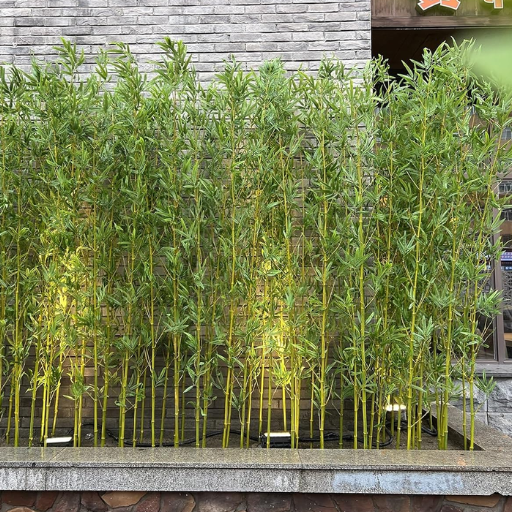
Artificial bamboo privacy fences are highly durable and require minimal maintenance, making them a practical and enduring option for homeowners. To create artificial bamboo, weather-resistant materials like PVC or composite resins are usually used, which can withstand harsh conditions like rain, UV, and frost without losing their quality, unlike natural bamboo.
Low Maintenance Requirements
Minimal upkeep is one of the main reasons to choose an artificial bamboo fence. Natural bamboo may need regular sealing or protection, while artificial bamboo fences usually require only occasional cleaning to remove dirt, dust, or debris. A simple water and mild soap mixture and either wiping or spraying is enough to keep the fence looking beautiful. Moreover, because of the fence's non-porous surface, mold, mildew, and insects are less likely to intrude, so the need for care is even less.
Longevity and Weather Resistance
Recent studies and reports indicate that high-quality artificial bamboo fences can last between 15 and 20 years or more, depending on environmental factors and product quality, for example, fencing made from UV-protected PVC is particularly effective in resisting fading or brittleness due to sun exposure. Furthermore, artificial bamboo's structural integrity remains intact even in regions that experience extreme weather, such as heavy rain and snow. This resilience translates into significant cost savings to homeowners over time as they won't have to replace or repair their fences so often.
Comparative Data
A report by home improvement experts reveals that artificial bamboo fences last approximately 10 to 15 years on average, compared to natural bamboo. Natural bamboo may develop cracks and warp within 5 to 10 years, while top-quality artificial options will still look great and perform well for much longer. Moreover, artificial bamboo fences can endure the -20°F to 120°F temperature range with almost no wear and tear, thus being a perfect choice for diffused climates.
With artificial bamboo privacy fences, modern homeowners can enjoy a combination of aesthetic appeal, durability, and low maintenance that aligns with contemporary living needs. The longevity and performance of the fences will be further improved with the use of higher-quality materials and proper installation.
Cleaning and Care for Your Bamboo Privacy Fence
By regularly cleaning and properly maintaining it, the bamboo privacy fence can not only live longer but also look better. Here are the five most important things to do and practices for keeping your artificial bamboo fence in amazing condition:
Routine Dusting
A soft brush or a microfiber cloth can be used for removing the surface dust and dirt that have accumulated over time on the bamboo. If this is done at least once every month, it will stop dirt from settling and the fence will continue to look fresh.
Gentle Washing
The fence should be cleaned with a mild soap and warm water solution. A sponge or a soft cloth can be used for scrubbing and then rinse with the garden hose. High-pressure washing should be avoided since it may damage the surface.
Periodic Inspections
Sign of wear, loosening of panels, or any damage should be checked regularly. Spotting minor issues and addressing them promptly can help prevent them from worsening, ensuring the fence stays strong and secure for a long time.
UV Protection
Bamboo can be sun-dried by applying a UV-resistant spray as a treatment. This process can minimize the fading of the material thus, making it more durable in the outdoors.
Avoid Harsh Chemicals
Do not use bleach, solvents, or abrasive cleaners, as they may damage the surface of the artificial bamboo. Always clean with gentle agents formulated explicitly for synthetic materials.
Eventually, these measures will not only maintain the attractiveness and utility of your bamboo privacy fence but also reduce the costs of potential repairs or replacements over time.
How to Extend the Life of Your Bamboo Screening
To extend the lifespan of your bamboo screening, you need to combine maintenance practices tailored to its natural and structural characteristics. Below are comprehensive tips supported by professional recommendations and current knowledge:
Apply a Protective Sealant
Although bamboo is naturally strong, it is still vulnerable to damage if left in moist conditions for prolonged periods. Regular application of a top-quality sealant that withstands all weather conditions every year or two will form an impervious water barrier. Sealants that have UV protection are especially recommended as they will block the sun's rays, which is one of the main factors that lead to fading and drying, thus, prolonging the life of your bamboo.
Provide Proper Drainage
Make sure your bamboo screening is not waterlogged by ensuring proper drainage. Water that remains can damage the fence. The installation of gravel or other drainage systems at the bottom of your fence will quicken the evaporation of water and keep the area moisture-free.
Regular Cleaning
Bamboo can be damaged by dust, moisture, and dirt over time. Treat the screening every three months with a soft cloth or sponge and lukewarm water with a bit of soap. Do not use power washers as high-pressure water can damage the structure.
Protect Bamboo Against Pests
Termites and insects are among the pests that attack bamboo. It is advisable to prevent such infestations by treating the bamboo screening with either an eco-friendly pest repellent (such as neem oil), which is natural, or with commercial pesticides.
Install a Shade Cover
Excessive direct sunlight will result in fading and drying. The installation of some partial shading, like that from a pergola or tree cover, is excellent as it reduces heat exposure and hence the lifespan of the material is increased.
Seasonal Inspection
At the start of each season, conduct a detailed inspection of the bamboo screening. Look out for signs of splitting, discoloration, or weakening. If there are any issues, address them immediately by sanding rough spots, applying fresh sealant, or cutting out and replacing the affected area.
Temperature Considerations
Temperature can cause bamboo to either expand or contract. The use of light-colored covers during the hot months can reduce heat absorption, or the use of insulated barriers can prevent the occurrence of damage due to freezing in winter.
Recent statistics show that well-maintained bamboo fences can last 15 to 20 years, while neglected ones last only 7 to 10 years. By applying these preventive strategies, not only will your bamboo screening remain structurally sound but also its natural beauty will be preserved for years.
Signs Your Bamboo Fence Needs Replacement
If I see major splitting, warping, or large cracks in the bamboo poles, it’s most likely time to replace them. Besides, mold, discoloration, or the constant presence of pests are strong indicators as well. Furthermore, if the structure's stability is affected—like parts leaning or supports weakening—it’s a clear sign that the fence has lived its life. All these problems can be detected early through routine inspections, but eventually, when repairs no longer work, installing a new fence becomes unavoidable.
Frequently Asked Questions (FAQ)
What are the benefits of using bamboo privacy fence panels?
Bamboo privacy fence panels offer an exclusive appearance and an eco-friendly alternative for outdoor areas. Besides providing the maximum outdoor privacy, they might become the focal point of your garden or patio. The bamboo-made panels are tough enough to require no maintenance, withstand extreme weather, and yet retain their natural beauty.
How do I install a synthetic bamboo fence?
The installation of a synthetic bamboo fence is quite simple and it generally requires just a few tools. You can follow the manufacturer's instructions to install it properly, which mostly means attaching the fence panels to either posts or the frame. One advantage of using synthetic materials is that they are lightweight, making it easy to handle and position the panels.
Are plastic bamboo screens effective for privacy?
Absolutely, plastic bamboo screens are a good option for making an outdoor privacy barrier. They not only have the same look as natural bamboo but also have added durability and UV resistance. So, they can be a good option for the privacy of your outdoor living area, because they are not only stylish but also practical.
What is the difference between faux bamboo and natural bamboo fencing?
Faux bamboo fencing is produced with artificial materials that are intended to imitate the appearance of real bamboo. On the other hand, natural bamboo fencing is made from real bamboo stems. Faux bamboo offers benefits like durability and weather resistance, while natural bamboo offers a more natural look but may require more care.
Can I use bamboo rolls as a decorative outdoor screen?
Bamboo rolls can serve comfortably as a decorative outdoor screen. They are adaptable and can be simply laid down as a privacy fence or a screen panel. Bamboo rolls not only offer a natural look that complements outdoor decor styles but also serve as a strong visual barrier.
What sizes do bamboo fence panels come in?
Bamboo fence panels are produced in many different sizes, usually around 4ft to 6ft tall. This wide selection of sizes can suit the different outdoor privacy demands and tastes of people. Pick the height that best meets your garden or patio requirements.
Are bamboo fence panels weatherproof?
Bamboo fence panels are unlikely to be damaged by weather, especially those made from synthetic bamboo. They repel harsh weather like rain and UV rays that can weaken other materials giving them a longer life. Thus, their weatherproofing makes them a good choice for outdoor fencing.
How do bamboo privacy screens compare to wood fences?
Bamboo privacy screens might often look more modern than classic wood fences. In general, these are lighter, easier to install, and require less maintenance. In contrast to wood, which can warp and sag over time, top-quality bamboo panels are crafted for strength and can retain their structural integrity for decades.
Can climbing plants be used with bamboo fencing?
Indeed, climbing plants can be an excellent addition to a bamboo fence. The bamboo fence vertical panel slats provide the right support for vines and climbing plants, which not only beautify but also create a lush green privacy screen for the outdoor living area.
Tags: Artificial Bamboo Privacy Fence

